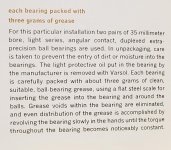metalmagpie
Titanium
- Joined
- May 22, 2006
- Location
- Seattle
I rebuilt a K.O. Lee grinder spindle once. They were still in business at that time. I called and they sent me the factory procedure. It called out some grease that was something like $500/pound. I visited my local machinery rebuilder (now gone, of course) and bitched and he gave me a little bit of the good grease. I remember I had to inject it into the ball bearings with a needle. I don't have the factory procedure anymore, and I don't remember what kind of grease it was.
Today I am cleaning and relubricating another K.O. Lee spindle. It is from a motorized workhead for a tool & cutter grinder. It is shown here:
http://nwnative.us/Grant/page7.pdf
I have completely disassembled the spindle. I have cleaned one bearing 100% and the other is soaking in solvent now. The PLY-A seals at one end were corroded around the steel retaining ring. I cleaned those and they are now soaking in Metal Rescue, an Evaporust-like derusting fluid.
The spindle bearings are Fafnir 2MM9112WICRDU. Outer ring, spider, 19 balls and the inner ring. They come apart with a little push. They had some issues but I am going to try to reuse them mostly because I don't feel like buying another set right now. K.O. Lee is long gone, so no factory support. I have a variety of greases, but I am not inclined to buy hundreds of dollars worth of grease for a few grams, so I the grease I use will probably come from my collection.
This spindle is a low speed spindle, 250 rpm tops. It looked to me like the bearings were filled full of grease last time.
I'm not working on this spindle because of noise issues - rather, when I turned the spindle by hand it felt crunchy. Dried grease? Dirt? don't know.
Do you have an opinion on what kind of grease I should use, and/or how full I should pack the bearings?
Thank you,
metalmagpie
Today I am cleaning and relubricating another K.O. Lee spindle. It is from a motorized workhead for a tool & cutter grinder. It is shown here:
http://nwnative.us/Grant/page7.pdf
I have completely disassembled the spindle. I have cleaned one bearing 100% and the other is soaking in solvent now. The PLY-A seals at one end were corroded around the steel retaining ring. I cleaned those and they are now soaking in Metal Rescue, an Evaporust-like derusting fluid.
The spindle bearings are Fafnir 2MM9112WICRDU. Outer ring, spider, 19 balls and the inner ring. They come apart with a little push. They had some issues but I am going to try to reuse them mostly because I don't feel like buying another set right now. K.O. Lee is long gone, so no factory support. I have a variety of greases, but I am not inclined to buy hundreds of dollars worth of grease for a few grams, so I the grease I use will probably come from my collection.
This spindle is a low speed spindle, 250 rpm tops. It looked to me like the bearings were filled full of grease last time.
I'm not working on this spindle because of noise issues - rather, when I turned the spindle by hand it felt crunchy. Dried grease? Dirt? don't know.
Do you have an opinion on what kind of grease I should use, and/or how full I should pack the bearings?
Thank you,
metalmagpie




